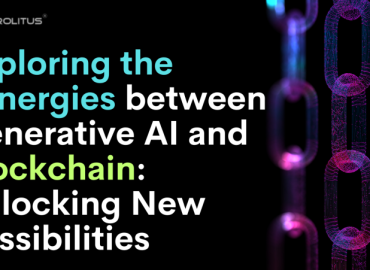Blockchain technology has been around since 1991, when Stuart Haber and W. Scott Stornetta first proposed the idea. The original goal was to create a system where documents could not be edited or tampered with after being published. Blockchain technology has a history that is deeply rooted in the digital currency Bitcoin. When Satoshi Nakamoto, the anonymous creator of Bitcoin, released the white paper for the cryptocurrency in 2008, he also detailed the blockchain technology that would power it. The blockchain is a distributed ledger technology that allows for secure, transparent, and tamper-proof transactions between two or more parties. This makes it an ideal choice for applications such as payments, data management, and identity verification. It can also be used to create digital assets and currencies. Because of its potential to be used in multiple applications, it quickly gained interest from other industries and developers who saw its potential beyond digital currencies.
Over the past decade, the blockchain has evolved and grown to become one of the most promising technologies available. Its ability to securely record transactions and data makes it an ideal solution for a variety of industries, including healthcare, finance, and supply chain management. The future looks bright for blockchain technology as more and more businesses start to adopt it into their operations.
Key elements of blockchain technology
Immutability
The term “immutability” refers to the fact that the blockchain is a network that cannot be changed in any way. Blockchain technology operates via a network of nodes to perform its duties.
The digital ledger is replicated on every node that makes up the network. When a transaction is added to the network, each node first verifies that the transaction in question is legitimate. If the vast majority of nodes agree that the transaction in question is legitimate, then it is added to the network. This means that no one can add transaction blocks to the ledger unless the majority of the nodes agrees to it.
Any record that has been validated is permanent and cannot be altered in any way. Because of this, it won’t be possible for any of the users on the network to modify, change, or remove it.
Decentralized
A decentralized network means that there is no governing body or one person in charge of maintaining the structure. Instead, the network is maintained by a group of nodes, which is decentralized.
This is one of the most important aspects of blockchain technology that works flawlessly. Let’s make it easier for you. We, the users, are in an easy position thanks to the blockchain. The system does not require a controlling body, so we can access it via the web and keep our assets there immediately.
Cryptocurrencies and other valuable digital assets can all be stored on this platform. As a result, you’ll be able to access them using your private key, thanks to the power of the blockchain. Because of this, the decentralized structure gives the general public back control over and ownership of assets.
Better Security
Since there is no central point of failure, blockchain technology is often seen as being more secure than its contemporaries. Data is constantly passed through multiple nodes rather than just one. This makes sure that the original data’s integrity won’t be compromised even if a single node is hacked or doesn’t work right.
Consensus
Each blockchain includes a consensus mechanism, which assists the network in making choices promptly while maintaining its neutrality. A decision-making procedure known as consensus enables a group of nodes that are actively participating in a network to come to terms with one another promptly and expediently, which is essential to the efficient operation of the system. Even if the nodes in the network do not trust each other, they can place their faith in the decision-making algorithm that is at the heart of the network. There are a wide variety of consensus algorithms available, and each one has both advantages and disadvantages. For a blockchain to work, it needs a consensus algorithm. Without it, the blockchain will quickly lose its value.
Faster Settlement
Traditional banking systems are notoriously sluggish, most likely because they demand a great deal of settlement time and typically take several days to complete a transaction. These banking institutions have a significant need to modernize their banking systems, and this is one of the primary reasons why. Blockchain technology, which allows for the extremely rapid settlement of money transfers, presents us with an opportunity to find a solution to this problem. In the long run, this saves these institutions a lot of time and money and makes things easier for their customers.
How does Blockchain Technology work?
You might have noticed that an increasing number of companies all around the world are implementing Blockchain technology in recent years. But how does the technology work behind the blockchain function? Is this a substantial adjustment or merely an additional feature? The innovations brought about by Blockchain are still in their infancy, but they have the potential to be game-changing in the not-too-distant future. Therefore, let’s start demystifying this technology.
The three most important technologies have been combined to create blockchain:
- The keys to the cryptosystem
- A decentralized peer-to-peer network that incorporates a shared ledger.
- A method of computation that can be used to record and save the network’s transactions and records.
The Private Key and the Public Key are the two parts that make up a Cryptography Key. These keys help in ensuring that transactions between two parties are completed successfully. Every person possesses these two keys, and to generate a safe digital identification reference, they must first use them. The most essential component of blockchain technology is how identities are protected. In the world of cryptocurrencies, this identity is called a “digital signature,” and it is used to approve and handle transactions.
The digital signature is combined with the peer-to-peer network. A large number of people who play the role of authorities utilize digital signatures to establish a consensus on many topics, including transactions. When they give their approval, the transaction is then subjected to mathematical verification, which ultimately leads to a successful and protected exchange between the two parties that are linked to the network. Participants in the Blockchain must use cryptographic keys to carry out a wide range of digital transactions across the peer-to-peer network.
What are the use cases of blockchain technology?
Gaming
As soon as cryptocurrency became popular for use in financial transactions and transactions involving money, programmers began creating blockchain games to demonstrate the many benefits that the technology can bring to the gaming industry in the form of solutions to issues such as economic manipulation by gaming companies, difficulties with payments, the possibility of shutdowns, and imbalanced gameplay. The implementation of an open-source, distributed, and transparent network for participants to participate in is what enables blockchain to provide innovations such as genuine ownership of assets; consensus-driven updates; decentralized marketplaces; simplified tokens; and several other advancements.
CryptoKitties, a game in which players may acquire and breed digital cats and in which all transactions are processed on the Ethereum blockchain, is considered to be one of the earliest and most popular instances of blockchain technology in operation. At one point in time, CryptoKitties was responsible for the majority of the hype on Ethereum, which caused it to dominate network traffic. Since the popularity of those blockchain games began to wane, developers have been hard at work creating other, more complex versions of the genre, such as Alien Worlds, Axie Infinity, Cartesi, The Sandbox, and others
Real Estate
The real estate business is plagued by issues such as sluggish transactions, administrative disputes, and distrust between buyers, sellers, and middlemen. Blockchain offers a solution to these issues by improving the quality of service provided. When blockchain technology is used in the real estate business, it makes it possible to automate routine tasks and contracts, save money, make listings and data tracking clear, and keep track of all important information.
In addition to improving customer service, blockchain enables the development of novel business models within the real estate industry. Some examples of these models are tokenized crowdfunding for real estate, fractional ownership of assets that would be hard to divide otherwise, and digital contracts that make transactions faster.
Insurance
The insurance sector is plagued with inefficiencies and is highly susceptible to fraudulent activity. The insurance business, which relies heavily on records, can reap the benefits of blockchain technology in several ways, including improved fraud detection, recordkeeping, and reinsurance (insurance for insurers). Because blockchain technology opens up new business models for insurance, insurers will also be able to offer more advanced versions of on-demand insurance and microinsurance.
Because the potential for blockchain insurance innovations to solve challenges is so strong, about 80 percent of insurance executives have either already deployed blockchain technology throughout their business divisions or plan to try it in the near future.
Implementing Blockchain in Insurance
Security
Blockchain technology offers answers to issues that arise at all levels of security, from individual bank accounts to the protection of entire nations. At the individual level, blockchain security solutions include self-sovereign identity, which gives users full control over their personal information, as well as protected data transmission, secure private messaging, and security layers for Internet-of-Things devices like thermostats and routers.
At the organizational level, businesses have begun implementing blockchain for distributed record-keeping to prevent denial-of-service assaults on websites and other single points of vulnerability. Even countries’ security systems, like those of Australia, Malta, and China, are starting to use blockchain technology.
Art
Non-fungible tokens, also known as NFTs, have emerged as a topic of intense interest in the realm of fine art ever since works of art made with the assistance of blockchain technology began fetching prices in the millions of dollars at public auctions. Crypto art and digital collectibles came into being as a result of the invention of non-fungible tokens (NFTs). Artists, singers, and influencers are increasingly embracing technology to make more money off of their original, one-of-a-kind work. The use of non-fungible tokens (NFTs) can range from digital artwork and music to documentation serving as proof of authenticity for physical assets such as works of art and jewelry.
How Prolitus can help you with building blockchain solution
Prolitus has been helping businesses with developing blockchain technology for a while now. We have a team of experienced professionals who can help your business get started with Blockchain technology. Our services include providing blockchain consulting; developing prototypes and protocols, carbon credit development and full-scale applications; and helping businesses with Blockchain integration and deployment.
We also offer support services so you can continue to use and improve your blockchain applications long after we’ve finished working with you. Connect with us today to discuss more about how Prolitus can help you build blockchain development solutions that are right for your business!





